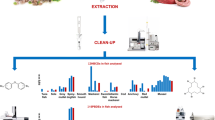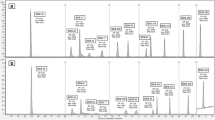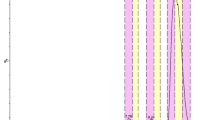Abstract
In this study, a novel analytical approach for simultaneous determination of hexabromocyclododecane isomers (HBCDs), tetrabromobisphenol A (TBBPA), three brominated phenols, and four hydroxylated derivatives of polybrominated diphenyl ethers (OH-PBDEs) was developed and validated for muscle tissue of both lean and fatty fish. The rapid, simple, and high-throughput sample-preparation procedure was based on acetonitrile extraction then purification by dispersive solid-phase extraction (d-SPE) with a combination of C18 and primary–secondary amine (PSA) sorbents. Ultra-high performance liquid chromatography (UHPLC) coupled to tandem mass spectrometry (MS–MS) was used for identification and quantification of the analytes. Method recovery for both matrices ranged from 80 to 115 % with relative standard deviations (RSDs) <13 % for all analytes. Limits of quantification (LOQs) were in the range 0.1–1 μg kg−1 wet weight. The validated method was used for analysis of brominated compounds in 32 fish and five bivalve samples collected from different European markets within the monitoring survey organized in the framework of the CONffIDENCE project. Of the 12 targeted analytes, only α-HBCD, 2,4-dibromophenol (2,4-DBP), and 2,4,6-tribromophenol (2,4,6-TBP) were quantified in the samples. α-HBCD was found in six fish samples (herring and mackerel) in the range of 0.8–2.5 μg kg−1 wet weight. 2,4-DBP and 2,4,6-TBP were found in three blue mussel samples in the range of 19.6–43.5 and 2.3–7.5 μg kg−1 wet weight, respectively.


Similar content being viewed by others
References
Alaee M, Arias P, Sjödin A, Bergman A (2003) An overview of commercially used brominated flame retardants, their applications, their use patterns in different countries/regions and possible modes of release. Environ Int 29:683–689
Covaci A, Gerecke AC, Law RJ, Voorspoels S, Kohler M, Heeb NV, Leslie H, Collin AR, de Boer J (2006) Hexabromocyclododecanes (HBCDs) in the environment and humans: a review. Environ Sci Technol 40:3679–3688
Covaci A, Voorspoels S, Abdallah MA, Geens T, Harrad S, Law RJ (2009) Analytical and environmental aspects of the flame retardant tetrabromobisphenol-A and its derivatives. J Chromatogr A 1216:346–363
Hajslova J, Pulkrabova J, Poustka J, Cajka T, Randak T (2007) Brominated flame retardants and related chlorinated persistent organic pollutants in fish from river Elbe and its main tributary Vltava. Chemosphere 69:1195–1203
Ueno D, Takahashi S, Tanaka H, Subramanian AN, Fillmann G, Nakata H, Lam PKS, Zheng J, Muchtar M, Prudente M, Chung KH, Tanabe S (2003) Global pollution monitoring of PCBs and organochlorine pesticides using skipjack tuna as a bioindicator. Arch Environ Contam Toxicol 45:378–389
Ueno D, Alaee M, Marvin C, Muir DCG, Macinnis G, Reiner E, Crozier P, Furdui VI, Subramanian A, Fillmann G, Lam PKS, Zheng GJ, Muchtar M, Razak H, Prudente M, Chung KH, Tanabe S (2006) Distribution and transportability of hexabromocyclododecane (HBCD) in the Asia–Pacific region using skipjack tuna as a bioindicator. Environ Pollut 144:238–247
Ueno D, Kajiwara N, Tanaka H, Subramanian A, Fillmann G, Lam PKS, Zheng GJ, Muchitar M, Razak H, Prudente M, Chung KH, Tanabe S (2004) Global pollution monitoring of polybrominated diphenyl ethers using skipjack tuna as a bioindicator. Environ Sci Technol 38:2312–2316
European Food Safety Authority. Request for data on brominated flame retardants levels in foodstuffs, http://www.efsa.europa.eu/en/data/call/datex091215.htm (accessed January 20, 2013)
EFSA Panel on Contaminants in the Food Chain (CONTAM); Scientific Opinion on Hexabromocyclododecanes (HBCDDs) in Food. EFSA Journal 2011;9(7):2296 http://www.efsa.europa.eu/en/efsajournal/doc/2296.pdf (accessed January 20, 2013)
EFSA Panel on Contaminants in the Food Chain (CONTAM); Scientific Opinion on Tetrabromobisphenol A (TBBPA) and its derivatives in food. EFSA Journal 2011;9(12):2477 http://www.efsa.europa.eu/en/efsajournal/doc/2477.pdf (accessed January 20, 2013)
EFSA Panel on Contaminants in the Food Chain (CONTAM); Scientific Opinion on Brominated Flame Retardants (BFRs) in Food: Brominated Phenols and their Derivatives. EFSA Journal 2012;10(4):2634 http://www.efsa.europa.eu/de/efsajournal/doc/2634.pdf (accessed January 5, 2013)
Covaci A, Voorspoels S, Ramos L, Neels H, Blust R (2007) Recent developments in the analysis of brominated flame retardants and brominated natural compounds. J Chromatogr B 1153:145–171
ten Dam G, Pardo O, Traag W, van der Lee M, Peters R (2012) Simultaneous extraction and determination of HBCD isomers and TBBPA by ASE and LC–MSMS in fish. J Chromatogr B 898:101–110
Guerra P, Covaci A, Eljarrat E, Barceló D (2011) Recent methodologies for brominated flame retardant determinations by means of liquid chromatography − mass spectrometry. Hdb Environ Chem 16:95–122
Nakagawa R, Murata S, Ashizuka Y, Shintani Y, Hori T, Tsutsumi T (2010) Hexabromocyclododecane determination in seafood samples collected from Japanese coastal areas. Chemosphere 81:445–452
Papachlimitzou A, Barber JL, Losada S, Bersuder P, Law RJ (2012) A review of the analysis of novel brominated flame retardants. J Chromatogr A 1219:15–28
Mariussen H, Haukås M, Arp HP, Goss KU, Borgen A, Sandanger TM (2010) Relevance of 1,2,5,6,9,10-hexabromocyclododecane diastereomer structure on partitioning properties, column-retention and clean-up procedures. J Chromatogr A 1217:1441–1446
Morris S, Bersuder P, Allchin CR, Zegers B, Boon JP, Leonards PEG, de Boer J (2006) Determination of the brominated flame retardant, hexabromocyclodocane, in sediments and biota by liquid chromatography–electrospray ionisation mass spectrometry. Trends Anal Chem 25:343–349
Goss KU, Arp HPH, Bronner G, Niederer C (2008) Partition behavior of hexachlorocyclohexane isomers. J Chem Eng Data 53:750–754
Frederiksen M, Vorkamp K, Bossi R, Rigét F, Dam M, Svensmark B (2007) Method development for simultaneous analysis of HBCD, TBBPA, and dimethyl-TBBPA in marine biota from Greenland and the Faroe Islands. Int J Environ Anal Chem 87:1095–1109
Morris S, Allchin CR, Zegers BN, Haftka JJH, Boon JP, Belpaire C, Leonards PEG, van Leeuwen SPJ, de Boer J (2004) Distribution and fate of HBCD and TBBPA brominated flame retardants in North Sea estuaries and aquatic food webs. Environ Sci Technol 38:5497–5504
Korytár P, Covaci A, de Boer J, Gelbin A, Brinkman UAT (2005) Retention-time database of 126 polybrominated diphenyl ether congeners ad two Bromkal technical mixtures on seven capillary gas chromatographic columns. J Chromatogr A 1065:239–249
van Leeuwen SP, de Boer J (2008) Brominated flame retardants in fish and shellfish – levels and contribution of fish consumption to dietary exposure of Dutch citizens to HBCD. Mol Nutr Food Res 52:194–203
Haug LS, Thomsen C, Becher G (2006) Comparing GC–MS and LC–MS for the determination of HBCD in food – results from an interlaboratory study. Organohalogen Compd 68:89–92
Guerra P, Eljarrat E, Barceló D (2011) Determination of halogenated flame retardants by liquid chromatography coupled to mass spectrometry. Trends Anal Chem 30:842–855
European research project CONffIDENCE (FP7–211326–CP). http://www.conffidence.eu. (accessed January 10, 2013)
Pulkrabova J, Hajslova J, Poustka J, Kazda R (2007) Fish as Biomonitors of Polybrominated Diphenyl Ethers and Hexabromocyclododecane in Czech Aquatic Ecosystems: Pollution of the Elbe River Basin. Environ Health Perspect 115:28–34
Lacina O, Zachariasova M, Urbanova J, Vaclavikova M, Cajka T, Hajslova J (2012) Critical assessment of extraction methods for the simultaneous determination of pesticide residues and mycotoxins in fruits, cereals, spices and oil seeds employing ultra-high performance liquid chromatography–tandem mass spectrometry. J Chromatogr A 1262:8–18
Mas S, Jáuregui O, Rubio F, de Juan A, Tauler R, Lacorte S (2007) Comprehensive liquid chromatography–ion-spray tandem mass spectrometry method for the identification and quantification of eight hydroxylated brominated diphenyl ethers in environmental matrices. J Mass Spectrom 42:890–899
Anastassiades M, Lehotay SJ, Stajnbaher D, Schenck FJ (2003) Fast and easy multi-residue method employing acetonitrile extraction/partitioning and “dispersive solid-phase extraction” for the determination of pesticide residues in produce. J AOAC Int 86:412–431
Vidal JLM, Frenich AG, Aguilera-Luiz MM, Romero-González R (2010) Development of fast screening methods for the analysis of veterinary drug residues in milk by liquid chromatography–triple quadrupole mass spectrometry. Anal Bioanal Chem 397:2777–2790
Frenich AG, Aguilera-Luiz MM, Vidal JLM, Romero-González R (2010) Comparison of several extraction techniques for multiclass analysis of veterinary drugs in eggs using ultra-high pressure liquid chromatography–tandem mass spectrometry. Anal Chim Acta 661:150–160
Zachariasova M, Lacina O, Malachova A, Kostelanska M, Poustka J, Godula M, Hajslova J (2010) Novel approaches in analysis of Fusarium mycotoxins in cereals employing ultra performance liquid chromatography coupled with high resolution mass spectrometry. Anal Chim Acta 662:51–61
Ramalhosa MJ, Paíga P, Morais S, Delerue-Matos C, Oliveira MBPP (2009) Analysis of polycyclic aromatic hydrocarbons in fish: evaluation of a quick, easy, cheap, effective, rugged, and safe extraction method. J Sep Science 32:3529–3538
Lehotay SJ, Mastovska K, Yun SJ (2005) Evaluation of Two Fast and Easy Methods for Pesticide Residue Analysis in Fatty Food Matrixes. J AOAC INTERNATIONAL 88:630–638
Li L, Zhang H, Pan C, Zhou Z, Jiang S, Liu F (2007) Multiresidue analytical method of pesticides in peanut oil using low-temperature cleanup and dispersive solid-phase extraction by GC–MS. J Sep Sci 30:2097–2104
Asplund L, Bugnert A, Nylund K (2004) Comparison of spatial and temporal trends of methoxylated PBDEs, PBDEs and hexabromocyclododecane in herring along the Swedish coast. Organohalogen Compd 66:3988–3993
Remberger M, Sternbeck J, Palm A, Jak L, Strömberg K, Brorström-Lundén E (2004) The environmental occurrence of hexabromocyclododecane in Sweden. Chemosphere 54:9–21
Knutsen HK, Kvalem HE, Thomsen C, Froshaug M, Haugen M, Becher G, Alexander J, Meltzer HM (2008) Dietary exposure to brominated flame retardants correlates with male blood levels in a selected group of Norwegians with a wide range of seafood consumption. Mol Nutr Food Res 52:217–227
Wan Y, Wiseman S, Chang H, Zhang XW, Jones PD, Hecker M, Kannan K, Tanabe S, Hun JY, Lam MHW, Giesy JP (2009) Origin of hydroxylatedbrominated diphenyl ethers: natural compounds or man-made flame retardants? Environ Sci Technol 43:7536–7542
Qiu X, Bigsby RM, Hites RA (2009) Hydroxylated metabolites of polybrominated diphenyl ethers in human blood samples from the United States. Environ Health Perspect 117:93–98
Whitfield FB, Helidoniotis F, Shaw KJ, Svoronos D (1999) Distribution of bromophenols in species of marine algae from eastern Australia. J Agric Food Chem 47:2367–2373
Gribble GW (2010) Naturally occurring organohalogen compounds: a comprehensive update. Progress in the Chemistry of Organic Natural Products 91. Springer Verlag. ISSN: 0071–7886
Löfstrand K, Malmvärn A, Haglund P, Bignert A, Bergman Å, Asplund L (2010) Brominated phenols, anisoles, and dioxins present in blue mussels from the Swedish coastline. Environ Sci Pollut R 17:1460–1468
Whitfield FB, Helidoniotis F, Smith D (2002) Role of feed ingredients in the bromophenol content of cultured prawns. Food Chem 79:355–365
Chung HY, Ma WCJ, Kim JS (2003) Seasonal distribution of bromophenols in selected Hong Kong seafood. J Agric Food Chem 51:6752–6760
Acknowledgement
This study was funded by the FP7 European project CONffIDENCE “Contaminants in food and feed: inexpensive detection for control of exposure” (no. 211326) and by the projects MSM 6046137305 and IDS 7E08068 supported by the Ministry of Education, Youth, and Sports of the Czech Republic.
Author information
Authors and Affiliations
Corresponding author
Additional information
Published in the topical collection Rapid Detection in Food and Feed with guest editors Rudolf Krska and Michel Nielen.
Electronic supplementary material
Below is the link to the electronic supplementary material.
ESM 1
(PDF 486 kb)
Rights and permissions
About this article
Cite this article
Lankova, D., Kockovska, M., Lacina, O. et al. Rapid and simple method for determination of hexabromocyclododecanes and other LC–MS–MS-amenable brominated flame retardants in fish. Anal Bioanal Chem 405, 7829–7839 (2013). https://doi.org/10.1007/s00216-013-7076-x
Received:
Revised:
Accepted:
Published:
Issue Date:
DOI: https://doi.org/10.1007/s00216-013-7076-x




